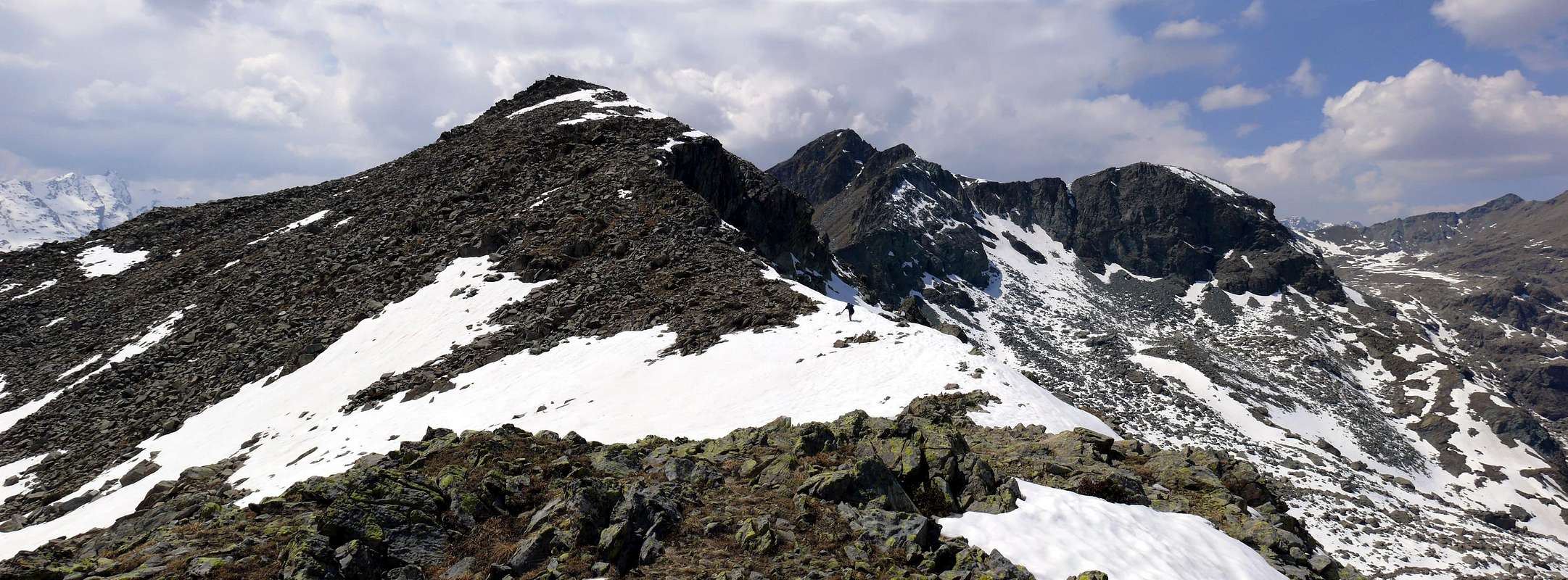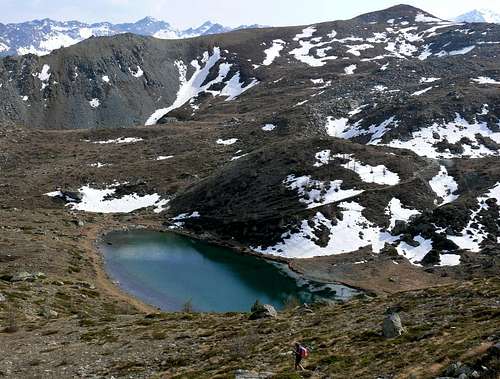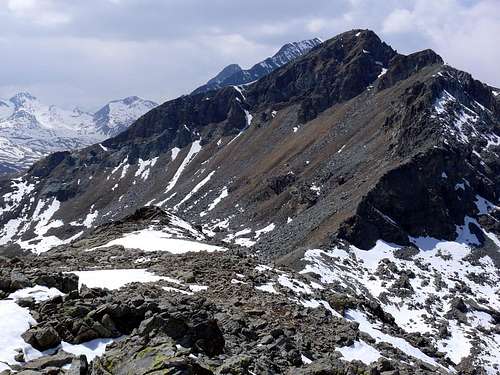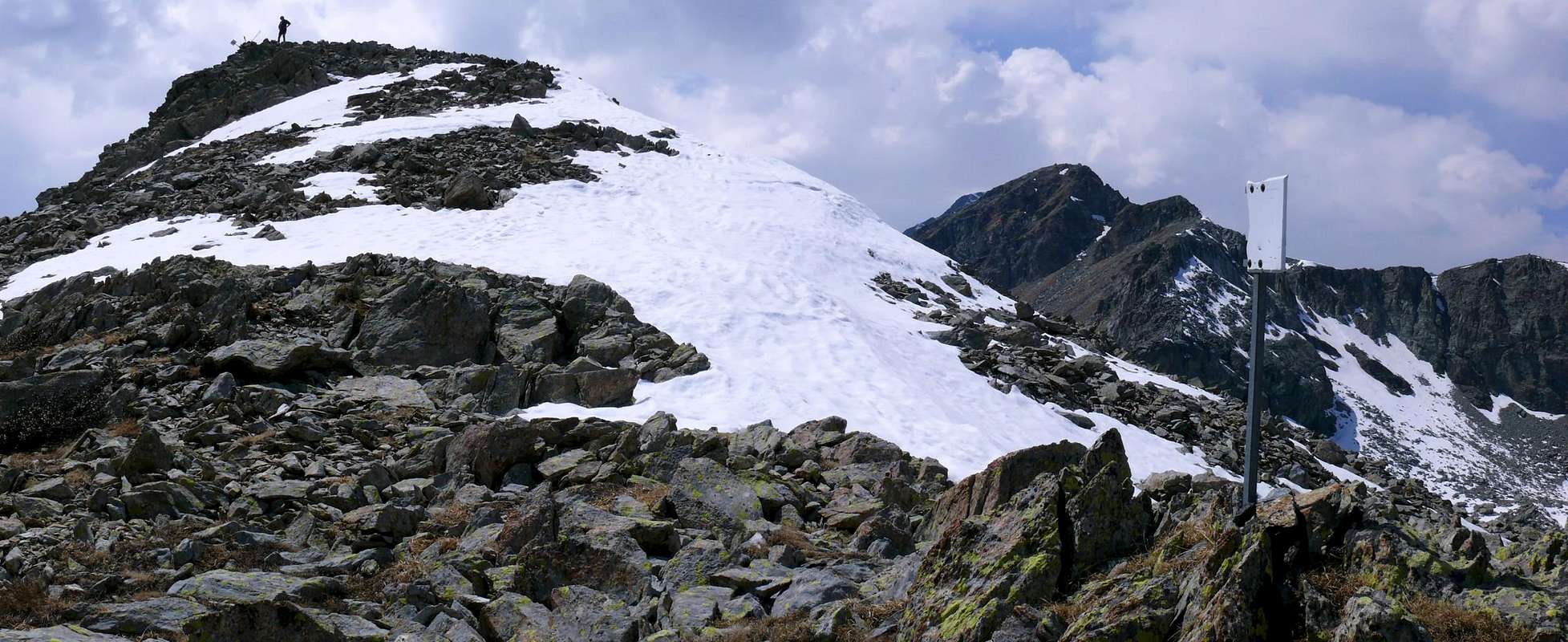-
 6617 Hits
6617 Hits
-
 81.84% Score
81.84% Score
-
 14 Votes
14 Votes
|
|
Mountain/Rock |
|---|---|
|
|
45.63790°N / 7.58168°E |
|
|
Mountaineering |
|
|
8576 ft / 2614 m |
|
|
Overview
Situated on the long crest that, going down from the Punta Tersiva (3.515m) maximum elevation, after the Monte Emilius (3.559m), of the mountainous chain to Southern of the River Dora Baltea beginning from the entry of the Valley of Cogne and up to the floor valley, above the to lot of small Town of Pont Saint Martin in the Valley of Aosta and on the lowland of beautiful City of Ivrea, "with the red towers". Following the crest watershed, departing from Tersiva Point, we will have in succession a series of mountains that they find their peak in the Mont Glacier (3.186m), to which small Subgroup also belongs the Tête des Hommes (= the Men's Head); in fact departing from this peak the dividing crest the Champorcher' Valley from those of Fénis-Clavalité in North, at first, and then from that of Champdepraz, said or Lochs's Valley. In order the same one, after two small Necks said of the Gran Rossa (= Great Red Pass) it raises again him to the homonym Point (2.866m), it goes down to a secondary collar to reach the Bocon Damon or Quota 2.792 m, so known by the inhabitants on the spot; after another small unnamed hill on the papers but known as Pass Raty (2.592m) and almost exclusively frequented by the hunters, forming a turn to arc the crest goes up again to the well most evident and marked Tete des Hommes. As top surely of not great importance, the same one him "it proposes" detaching itself and delineating very well itself both from the slope Raty-Vernouille that from that Northern, where it overhangs the whole splendid series of surrounding lakes the Barbustel Refuge (2.200m). The same is site in pleasant way among three lakes: the White, the Black and the Vallette Lake more to East; rather rarely frequented (perhaps for his enough tiresome aspect, if observed from the lakes or from the basin of the Raty, where it raises him with a dizzy but brief West Crest; AD; also III°) in reality introduces an easy and sure slope along the Slope Southeast and only a few tedious in the crossing, along a great stony ground with enormous "clapeys" (= great stacked rocks). To cross, before to West and afterwards with Northwest direction, from the common path n° 10 that from the Villages of the Petit Mont Blanc (1.537m) and of the Grand (1.683m) or, and better, from that superior of La Cort (1.800m around; term of the road asphalted with possibility to continue with the cars along the Real Road of thin Dondena to a small parking with signalings for the shelter however.) From this point (rich and various illustrative poster designer also with maps in site) even and besides the entry into the entire, complete and really wild

Situata sulla lunga cresta divisoria che, scendendo dalla Punta Tersiva (3.515 m) massima elevazione, dopo il Monte Emilius (3.559 m), della catena montuosa a Meridione del Fiume Dora Baltea a partire dall'ingresso della Valle di Cogne (dal Comune di Aymavilles) e fino al fondovalle, sopra la piccolissima Città di Pont Saint Martin in Valle d'Aosta e sulla pianura della bella Città di Ivrea, "dalle rossi torri". Seguendo la lunga ed articolata cresta spartiacque, partendo dalla Tersiva, avremo in successione una serie di montagne che trovano il loro culmine nel Mont Glacier (3.186 m), al quale piccolo Sottogruppo appartiene quindi anche la Tête des Hommes (= Testa degli Uomini); infatti partendo da questa vetta piramidale la cresta divisoria la Valle di Champorcher da quelle di Fénis-Clavalité, dapprima (ad O), e poi da quella di Champdepraz, detta anche Valle dei Laghi si allunga sull'asse Ovest/Est, seguendo in parallelo in pratica il corso della Dora Baltea. In ordine la medesima, dopo due Colletti detti della Gran Rossa, si rialza all'omonima Punta (2.866 m), ne discende ad un successivo e secondario per raggiungere il Bocon Damon oppure Quota 2.792 m, così conosciuto dagli abitanti in loco; dopo un altro piccolo colle, innominato sulle carte ma conosciuto dai valligiani come Colle Raty (2.592 m) e frequentato quasi esclusivamente dai cacciatori, formando un giro ad arco la cresta risale alla ben più evidente e marcata Tete des Hommes. Per quanto cima sicuramente di non grande importanza, la stessa si "propone", staccandosi e delineandosi molto bene, sia dal versante Raty-Vernouille (Valle di Champorcher) che da quello Settentrionale, dove sovrasta tutta la splendida serie di laghi circostanti il Rifugio Barbustel (2.200 m). Lo stesso é sito in modo ameno in un piccolo promontorio in mezzo a tre laghi: il Bianco, il Nero ed il Lago Vallette più a Oriente; alquanto raramente frequentata (forse per il suo aspetto abbastanza ostico, se osservata dai laghi o dal bacino del Raty, dove s'innalza con una vertiginosa, ma breve, Cresta Ovest (AD; anche III°); in realtà presenta una salita facile e sicura lungo il roccioso e detritico Versante SE, soltanto un poco tediosa nell'attraversamento, lungo una grande e desolata pietraia con enormi "clapeys" (= grandi massi accatastati). Attraversare, dapprima verso O e quindi direzionandosi a NO dal comune sentiero n° 10, che dai Villaggi del Petit Mont Blanc (1.537 m) e del Grand (1.683 m) o, e meglio, da quello superiore di La Cort (1.800 m~; termine della strada asfaltata con possibilità comunque di proseguire con l'auto lungo la Strada Reale di Dondena fino ad un piccolo pargheggio con segnalazioni per il rifugio.) Da questo punto (ricca e varia cartellonistica anche illustrativa con mappe in sito) si effettua inoltre anche l'ingresso nell'integro, incontaminato e veramente selvaggio
PARCO NATURALE del MONTE AVIC
con le sue valli ed i suoi valloni, a volte, anche di non facile accesso (soprattutto sul versante del Comune di Champdepraz) e le sue antiche miniere di ferro e di rame, ormai abbandonate. Scarsamente conosciuto (* se non nell'area vicina al rifugio con la successione dei suoi laghi sino al Gran Lago od al Col Medzove (2.614 m), dove transita il sentiero intervallivo n° 102 che, attraversando di valle in valle, arriva sino alla Frazione del Pont Suaz, alle porte della Città di Aosta), ma non per questo meno affascinante e meritevole di una visitazione. Lo stesso sentiero, risalito all'Alpeggio di La Grand Cort (1.944 m), transitando per il Lac Muffé (2.019 m), rimonta al Colle del Lago Bianco (2.308 m) per introdursi nel Vallone dei Laghi con il suo Gran Lago oppure Grand Lac (2.492 m), il più grande dell'intera Valle d'Aosta. Ed é proprio a questo colle che si "lega" la nostra montagna con la sua Cresta NE che, scesa ad un ulteriore colle secondario (2.450 m~) e rialzatasi momentaneamente ad una torretta rocciosa, detta per l'appunto "Mont Torretta" o meglio "La Torretta" (2.538/9 m), scende definitivamente sullo stesso. Gita piacevole e sicuramente inconsueta (splendida con innevamento e quindi per lo sci-alpinismo o con racchette da neve) e riservata a coloro che amano uscir fuori dalle strade comunemente battute ed affollate; stacco che si evidenzia maggiormente proprio abbandonando il sentiero pel colle, dove di estate si riversa una terrificante fiumana umana, per inserirsi in un piccolo ed aspro vallone, dimenticato da Dio e dagli uomini. Al ritorno. dopo la discesa lungo il medesimo versante, una breve traversata in quota, doppiando alla base e verso NE "La Torretta", al passo e relativa discesina al rifugio con bel pranzo a polenta e camoscio o cervo completano alla grande la giornata! Per rientrare nella realtà e non essere tacciati d'essere degli asociali ... Belle viste sul circondario, con la snella, triangolare e lucente Punta Tersiva ed il più tozzo Mont Glacier, che da qui appar altissimo, ed il suo "Spallone Meridionale" o Quota 3.003 m, nonché l'attiguo piamidale Mont Delà (3.139 m). In lontananza a NO il GRUPPO dell'Emilius ed il Sottogruppo delle Roises, mentre a Meridione, sopra il Vallone dei Banchi e verso il Lago Miserin (2.578 m), s'innalza, a guisa di sciabola, la slanciata Rosa dei Banchi (3.164 m), simbolo della Valle di Champorcher, al confine con il vicino Piemonte (in successione da E-NE ad O-NO Valli dell'Orco, Locana e Ceresole Reale). La stessa é anticipatoria della Catena del Gran Paradiso dalla medesima estendentesi a sconfinata vista d'occhio verso le Valli dell'Isère, nella lontana fascinosa Francia.
First Ascents
- First on the Summit: Unknown.
- In Winter: Unknown.
- W Edge: Unknown.
- NE Ridge: Unknown.
- SE Slope and NE Crest in final part (Standard Route): Unknown.
Getting There
BY CAR:- From Torino, Milano, etc: Motorway A5. Exit Pont Saint Martin for then to continue on SS26 toward Hone Bard.
- From Switzerland: through the Grand Saint Bernard Tunnel or the namesake pass. Drive to Aosta, Fénis Village or Verrès and Hone Bard.
- From France: through Mont Blanc Tunnel or Petit Saint Bernard Pass. It isn't necessary to take Motorway A5: you can drive on SS.26, in the direction of Aosta and Fénis Village or Verrès and Hone Bard.
- Aeroporto "Corrado Gex" Saint Christophe (Aosta).
Approaches of Base for whole the AREA neighbour the "ROYAL ROAD"
Approach to Pass of Lago Bianco (White Loch)
From the small Village of La Cort, to continue verse West-northwest on the Real Road in earth for Dondena Village reaching not very after a small parking lot near and along the same one (1.830/40m around; noumerous signalings and entry "official" in the Park of the Avic Mountain); to begin awry immediately with the path n° 10 that part (North) and it goes up again with a steep zigzag bringing itself, with direction Northeast, at first toward a small secondary torrent and subsequently placing side by side that more important descendant from the impending Loch Muffé. To go up again along the bank right hydrographic of the same one with the path, almost mule-track, that unties him with a series of hairpin bends flanking the wood, alternate to rectilinear lines in diagonal. To go out, leaving on the right (East) the deviation for the "Alpage" of La Grand Cort (1.944m, that from he is quietly seen here "abandoned" among green pastures) so in the superior plateau in her "wide narrow passage" among the appendixes of the Mont Ros (2.289m) to West and you it terminal of the SW Crest that it climbs to the Top Perche (2.396m; also with the toponym of Perché, or Perforated), or Southern shoulder of the Cima Piana (= Plain Top also called Mont de Panaz 2.512m). Continue on the floor of the walloon through less steep slope with run mostly "open" and, abandoning on the left (West) the deviations for the Lacke Vernouille (2.145m) with the paths n° 9C, 10B and, momentarily, also the n° 10, to climb with the n° 10C reaching the ruin of the old Alp Muffé (2.076m), close to the homonym Lake suffered to East I approach (2.119m; 0h'30). From this to ascend up with direction Northwest in a zone even more disclosed among small backs with lawns and moraines (small sources that gush out a little everywhere) again meeting the path "of base" n°10, that it originates "of return" from the Lac Vernouille, few more than hundred meters more aloft. To abandon therefore the aforesaid variation continues with, that continues in opposite direction (Northeast) toward the nearby Colle del Lago Bianco (= White's Loch Pass; 2.308m), and to proceed with this last I pour the neighbour Col de la Croix (= Hill of the Croix; 2.287m), reaching it with a final line of a little steep (E; 1h'15/1h'30).Route
From the quota 2250/300 meters around, to the intersection of the paths n° 10C and 10, to abandon these last ones leaving them on the right (in direction of trailway toward of the White Lake (2.308m) and of the Cross Pass (2.287m), the both between Champorcher and Champdepraz's Valleys) in opposite addressing to West; to cross at first along the slope with bushes, blocks, debris and deposits for then, going down of some about ten meters, to go himself in a minuscule walloon which it follows a stony ground of great "clapeys." To cross it around 2.225/35 meters, doing small "stunts" among the sundry rocks at times too outdistanced between them and therefore without solution of continuity in the traverse and passing, subsequently, in the middle of two small rocky bends; doubling to the base the South Wall of the "La Torretta", to get in himself to quota 2.300 meters about in a small "vallone", site between the same one and the Tête des Hommes. Flanking the same, to go up again it with direction North-northwest almost bringing himself on the Southeast Slope of this last. Long moraines, shed blocks and some lean rocky bends, to climb holding more or less himself in the center of the vallon, leaving on the left the Southeast Slope real, discreetly constituted by one steep "strained" of stops broken; to reach easily so a wide saddle among these two mountains (2.450 meters around) for then to continue with easy slope in direction Southwest through the Crest Northeast, with possibility to find some snowcappeds residue, and with this to reach, again without particular difficulties, the Peak with its three signals (E; 0h'30/2h'00 from the parking lot on Royal Road and in quota 1.830/40m about).Equipment
For Excursion and ski or snowshoes, in presence of strong snow.Campings
Remember that free camping is forbidden (except for emergency reasons, over 2.500m, from darkness until dawn).Huts

Mountain Conditions
- You can get meteo information at the official site of the Regione Valle d'Aosta:
- Valle d'Aosta Meteo
Webcam
- WEBCAM on Aosta Valley:
- Webcam
Books and Maps
BOOKS:- "Guida delle Alpi Occidentali" di Giovanni Bobba e Luigi Vaccarone C.A.I. Sezione di Torino Volume II (parte II), 25 Maggio 1896.
- "Guida dei Monti d'Italia – Emilius Rosa dei Banchi-Parco del Mont Avic" di Giulio Berutto e Lino Fornelli - Club Alpino Italiano/Touring Club Italiano, Marzo 2005.
- "Diari Alpinistici" di Osvaldo Cardellina e Indice Generale accompagnato da Schedario Relazioni Ascensioni 1964-2019 (inediti).
- Ingenia "Parco Naturale del Mont Avic" Carta dei sentieri 1:25.000.
- Enrico Editori Ivrea "Carta turistica del Canavese" 1:100.000
- Enrico Editore Ivrea-Aosta "Gruppo del Gran Paradiso" 1:50.000.
- L'Escursionista editore "Valle di Champorcher Parco Mont Avic" Carta dei Sentieri (11) 1:25.000.
- L'Escursionista "Valle di Cogne" Carta dei Sentieri 1:25.000.
Important Information
- REGIONE AUTONOMA VALLE D'AOSTA the official site.
- FONDAZIONE MONTAGNA SICURA Villa Cameron, località Villard de la Palud n° 1 Courmayeur (AO) Tel: 39 0165 897602 - Fax: 39 0165 897647.
- A.I.NE.VA. (Associazione Interregionale Neve e Valanghe).
Useful Numbers
- Protezione Civile Valdostana località Aeroporto n° 7/A Saint Christophe (Ao) Tel. 0165-238222.
- Bollettino Meteo (weather info) Tel. 0165-44113.
- Unità Operativa di Soccorso Sanitario Tel. 118.















